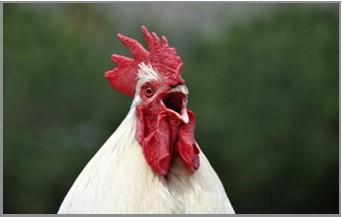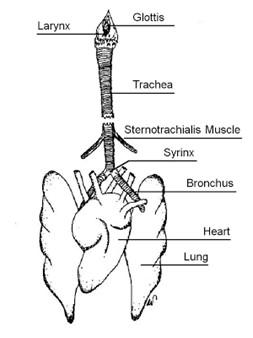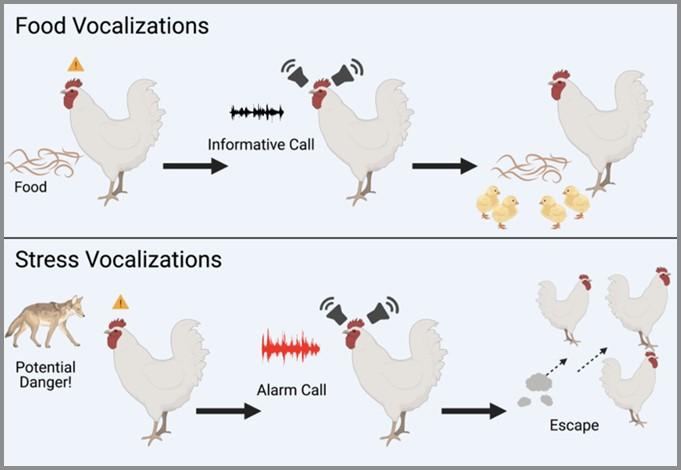
FS-1177 | September 2021
Relationships Between Chicken Vocalizations and Health, Behavior, and Welfare

Chickens make different vocalizations for a variety of reasons. Determining the reasons behind vocalizations and understanding how chickens use them is a great way to gain insight into their health, behavior, and overall welfare. Broilers, roosters, laying hens, and even the chickens in a backyard flock constantly vocalize to communicate with each other.
Some of the most common chicken vocalizations are:
- roosters’ crows
- food calls
- alarm calls
- hens’ post-laying "cackles"
- chicks’ distress calls
- hens’ gakel calls
Creating and Hearing Sound
Understanding how chickens hear can be an important step in identifying their vocalization patterns and uses. Chickens’ ears are divided into three sections: the inner, middle, and outer ear. When the outer portion of the ear receives an acoustic sound wave, it is converted into vibrations of the eardrum. Those vibrations are transmitted through the middle ear into the inner ear where they are ultimately transformed into nerve impulses by the cochlea. The anatomy of the chicken ear has a significant effect on what they can hear. Researchers found that red junglefowl chicks can hear sounds best when they are at a frequency of 1410 Hertz (Saunders & Salvi, 1993).
How Chickens Create Sound

Birds are unique in the way they produce sound. Chickens have air sacs and a syrinx (Figure 1) that they use to push air out of the body and cause thin (tympaniform) membranes to vibrate and create noise (Otu-Nyarko, 2010). Chickens can control how a vocalization sounds by contracting and relaxing the syrinx muscles.
Chickens’ Unique Hearing Qualities
Damaged hair cells are the main cause of hearing loss in humans. Unlike humans, chickens can regrow damaged hair cells within their ear even as they age (Jacob, eXtension). Because of this unique ability, research with poultry species could help us develop future treatments for human hearing loss (Jacob, eXtension). When it comes to hearing frequency range, humans are superior. Chickens (specifically Red Junglefowl) can only hear sounds within 200 to 4100 vibrations per second (Hz), while humans can hear sounds within 20 to 20,000 Hz (Saunders & Salvi, 1993; Science World, 2020).
Chickens and other birds can hear and register sounds more quickly than humans (Jacob, eXtension). To determine the distance and location of a sound, chickens assess the time it takes for a sound to reach their ears (Jacob, eXtension). Their ability to easily perceive sounds helps them avoid predators and potential danger.
Did you know?
Chicken embryos start to hear around their 12th day of embryonic development during incubation! (Jacob, eXtension).
What Do Chicken Vocalizations Mean?
Social communication is important for chickens, especially in commercial settings where there are many birds in close proximity. Chickens use different vocalizations to communicate their needs, which can vary among breeds. Broilers are chickens raised for meat production and are highly motivated to eat (O’Connor, 2021). Layer chickens are selected for egg production; some can lay over 250 eggs per year (O’Connor, 2021). Due to these variations in breeds and environment for laying hens, broilers, and small flocks, there are likely differences between the types of vocalizations these animals use most often. Reproductive vocalizations are also important. The type of vocalizations chickens make can vary based on sex and age (Jacob, eXtension).
Communication is Key to Survival
After hatching, chicks are typically very explorative and open to learning from their mother. This is known as the imprinting phase (Fontana et. al, 2015). Mother hens are known to make "food calls," which are auditory clues to help chicks learn which foods are safe to eat (Jacob, eXtension). “Calling sounds” and “distress calls” are often seen in very young broiler chicks when isolated or stressed (Fontana et. al, 2015). Chickens are also social animals, operating in ways which protect the entire flock. Alarm calls are used to keep the flock safe and aware of danger (Jacob, eXtension).

Family Matters
Roosters often “crow” to communicate dominance over other chickens or to indicate safety for the flock (Jacob, eXtension). They can also give alarm calls when there are potential predators nearby. Roosters also use “tidbitting” to indicate a food source and make “purring” vocalizations towards hens that could be potential mates (J.Moyle, personal communication).
Hens emit pre-lay vocalizations before entering a nest to lay eggs. In feral hens specifically, the pre-lay call may attract males attempting to breed (Jacob, eXtension). Hens are also known to give a post-laying “cackle” after laying eggs (Jacob, eXtension). This is a unique collection of short vocalizations followed by an elongated one. It is believed that the purpose of this post-laying vocalization is to inform males that the hen is less likely to be receptive to fertilization at that time. Hens often give a gakel call to indicate frustration with their environment (Zimmerman et. al, 2003). This is a common response to changes in food availability and is often associated with frustration behaviors such as stereotyped pacing or displacement preening (Zimmerman et. al, 2003).
Fun Fact:
Chicks raised without a hen have shown increased eating behaviors when they hear tapping sounds. This is likely because the sound is similar to the pecking noise of an actual hen. (Jacob, eXtension).
Recent Advancements in Chicken Vocalization Research
Since 2010, there has been a significant increase in the research to learn more about how poultry vocalizations relate to health and welfare. Modern sound analysis techniques enable us to discriminate, analyze, and
classify specific animal vocalizations. Recent research has emphasized using these techniques to attribute distress vocalizations to environmental and behavioral contexts (Manteuffel et al., 2004). Learning more about the physiological parameters associated with vocalizations will help those who own farm animals better understand how to increase the well-being of their animals, including poultry (Manteuffel et al., 2004). For example, correlations between the entropy (disorder) of distress calls and chicken welfare have been found; there is potential for entropy to be used as a predictive welfare-relevant measure in a commercial setting (Herborn et al., 2020).
Stress
We can say an animal experiences “stress” when a physiological or behavioral response is stimulated in the body due to a change in that animal’s environment (Harvey et al., 1984). Stressors can be a combination of physical or mental factors which can negatively impact the animal, both in the moment or over time (Harvey et al., 1984). Common causes of stress in poultry consist of certain management practices, such as stocking density, and poor environmental conditions (Sassi et al., 2016).
Research indicates that there is a connection between chicken vocalizations and their stress (Weary & Fraser, 1995). Some stressors are more manageable than others. Inadequate space and starvation, for example, are avoidable stressors, while stress associated with vaccinations and transportation may be unavoidable (Mohan, 2005). When proper welfare conditions are not provided for poultry, they are likely to experience physical stressors from injury, poor litter conditions, or inadequate temperatures. These physical stressors may ultimately lead to mental stressors like fear and pain (Elrom, 2000).
Animal calls are communication signals that have evolved to enable them to suggest their needs and physical state to other individuals. Therefore, it is reasonable to record and analyze vocalizations and attempt to use them as welfare indicators (Dawkins, 1998). Since chickens have distinctive vocalizations they use under different stressful conditions, those vocalizations can serve as tools for early stress detection in flocks (Otu-Nyarko, 2010).
Production
In 2020, researchers conducted acoustic analysis of audio gathered from a commercial broiler farm in the Mediterranean (Ginovart-Panisello et al., 2020). The authors found that there were more vocalizations during dark periods and that peak frequency of vocalizations decreased with age. They were able to detect deeper vocalizations in older birds, and reported the peak frequency decreased by about 1,000 Hz over the entire production cycle, indicating the vocalizations decreased in pitch over time. Increases in peak frequency were also found to be correlated with decreases in food and water intake. Low peak frequencies of vocalizations could indicate low stress and higher production performance on-farm. The authors also emphasized the importance of proper farm management practices on the welfare status of a flock.
Disease
Recent research has emphasized investigating poultry vocalizations related to disease. Avian diseases targeting the respiratory system, such as infectious bronchitis, are among the most threatening diseases for poultry flocks (Schat et al., 2014). Typical signs of respiratory disease in poultry are abnormal breathing sounds such as coughing and sneezing, often referred to as rales (Manning et al., 2007). Respiratory diseases are detrimental in poultry flocks because they can lead to decreased performance, damage the syrinx and trachea, and affect respiratory functions and vocalizations (Mahdavian et al., 2021).
In their 2021 study, Mahdavian and colleagues sought to determine which acoustic features in vocalizations would best support broiler health monitoring. The authors investigated the potential of using different auditory features as criteria for the diagnosis of specific poultry respiratory diseases, specifically on infectious bronchitis and Newcastle disease. Individual sounds from 150 healthy commercial broiler chickens were compared to those from 150 broiler chickens with either bronchitis or Newcastle disease at 10 days of age (Mahdavian et al., 2021). Wavelet entropy, the spectrum entropy of decomposed signals, was the most reliable feature for detecting bronchitis (Mahdavian et al., 2021). The results of this study indicated that analyzing non-decomposed audio was not helpful in detecting the onset of disease in broilers and that more research is needed to create an algorithm that is reliable, consistent, and functional in farm conditions.
Researchers also investigated sound-based monitoring of sneezes as an indicator of respiratory disease in broilers. In a 2019 experiment, researchers recorded audio from multiple birds together in a cage and concluded that it was possible to monitor the number of sneezes in groups of 15 and 36 birds (Carpentier et al., 2019). While the sneeze-labeling ability of the automated algorithm was not perfect, researchers found that there were more sneeze sounds per minute during light periods compared to dark periods (Carpentier et al., 2019). Since sneezing is known to be a clinical manifestation of multiple respiratory problems, especially during periods of low animal activity like nighttime, the automated monitoring of such sounds could be extremely beneficial for future disease monitoring techniques (Du et al., 2018; Carpentier et al., 2019). This preliminary research, using a specific algorithm to analyze bird vocalizations, is considered the first step in developing automated sound-based monitoring of poultry health (Carpentier et al., 2019).
We now know that bird vocalizations can signal bird activity and distress call prevalence, and that monitoring peak frequency in audio can help detect vocalizations (Ginovart-Panisello et al., 2020). To obtain suitable audio measurements from poultry vocalizations, advanced technology with broiler-specific algorithms should be applied as the audio is analyzed (Mahdavian et al., 2021). While many aspects of vocalizations can be measured and standardized, spectral entropy seems to be most useful when it comes to predicting respiratory disease and stress levels in flocks. In commercial flocks, monitoring sounds related to sickness, such as sneezing, could be a promising method of early disease detection (Carpentier et al., 2019). Although much of the research regarding vocalizations and disease has been conducted using vocalizations from individual birds or small groups of birds in laboratory settings, there is a potential for these methods to be functional in large-scale commercial settings as well.
What Do Chicken Vocalizations Tell Us About Their Behavior and Welfare?
Much research has been done to develop strategies to assess the welfare of chickens. These attempts at evaluating behavior or stress measures are often useful but not quite comprehensive enough to be solely relied on (Manteuffel et al., 2004). Since vocalizations are good indicators of health and affective state, there has been a recent interest in chicken vocalizations as researchers aim to learn as much about them as possible.
Food calls, crowing, and other calling sounds are normal vocalizations heard in flocks and are often associated with species-specific behavior. Monitoring the amount of distress calling in a backyard flock or commercial house can be a good way to bring fear behavior (running away from stressors, alerting of potential predators, etc.) to one’s attention (Herborn et. al, 2020). Changes in behavior often indicate changes in health or welfare, and monitoring flock vocalizations could help caretakers notice any significant changes and other potential problems in flock behavior.
When vocalizations are combined with other behaviors, farmers and researchers can get a clearer idea of individual and flock welfare status. Whether chickens are seen as pets or livestock, we want to take every step possible to ensure they are healthy and comfortable in their environment.
References
- Ben Sassi, N., Averós, X., & Estevez, I. (2016). Technology and Poultry Welfare. Animals, 6(10).
- Carpentier, L., Vranken, E., Berckmans, D., Paeshuyse, J., & Norton, T. (2019). Development of sound-based poultry health monitoring tool for automated sneeze detection. Computers and Electronics in Agriculture, 162, 573–581.
- Dawkins, M. S. (1998). Evolution and Animal Welfare. Q. Rev. Biol. 73, 305-328.
- Du, X., Lao, F., & Teng, G. (2018). A Sound Source Localisation Analytical Method for Monitoring the Abnormal Night Vocalisations of Poultry. Sensors, 18(9), 2906.
- Elrom K. (2000). Review: handling and transportation of broilers - welfare, stress, fear and meat quality. Part III: Israel Journal of Veterinary Medicine Volume 53(3).
- Fontana, I., Tullo, E., Scrase, A., & Butterworth, A. (2016). Vocalisation sound pattern identification in young broiler chickens. Animal, 10(9).
- Ginovart-Panisello, G. J., Alsina-Pagès, R. M., Sanz, I. I., Monjo, T. P., & Prat, M. C. (2020). Acoustic Description of the Soundscape of a Real-Life Intensive Farm and Its Impact on Animal Welfare: A Preliminary Analysis of Farm Sounds and Bird Vocalisations. Sensors, 20(17), 4732.
- Harvey, S., Phillips, J. G., Rees, A., & Hall, T. R. (1984). Stress and adrenal function. Journal of Experimental Zoology, 232(3), 633–645.
- Herborn, K. A., McElligott, A. G., Mitchell, M. A., Sandilands, V., Bradshaw, B., & Asher, L. (2020). Spectral entropy of early-life distress calls as an iceberg indicator of chicken welfare. Journal of The Royal Society Interface, 17(167).
- Jacob, J., Dr. (n.d.). eXtension – Small and backyard poultry. How well can poultry hear? Retrieved March 2021, from https://poultry.extension.org/articles/poultry-anatomy/how-well-can-poultry-hear/.
- Jacob, J., Dr. (n.d.). Vocalization of chickens in small and backyard poultry flocks. Retrieved March 2021, from https://poultry.extension.org/articles/poultry-behavior/vocalization-of-chickens-in-small-and-backyard-poultry-flocks/.
- Mahdavian, A., Minaei, S., Marchetto, P. M., Almasganj, F., Rahimi, S., & Yang, C. (2021). Acoustic features of vocalization signal in poultry health monitoring. Applied Acoustics, 175, 107756.
- Manning, L., Chadd, S. A., & Baines, R. N. (2007). Key health and welfare indicators for broiler production. World's Poultry Science Journal, 63(1), 46–62.
- Manteuffel, G., Puppe, B., & Schön, P. C. (2004). Vocalization of farm animals as a measure of welfare. Applied Animal Behaviour Science, 88(1-2), 163–182.
- Mohan, J. (2005). Physiology of stress in poultry Central Avian Research Institute, Izatnagar (UP)-243 122.
- O'Connor, K. (2021). The genetically modified chicken: How we have altered 'broiler' chickens for profit. Retrieved March 2021, from https://www.onegreenplanet.org/animalsandnature/the-genetically-modified-chicken-how-we-have-altered-broiler-chickens-for-profit/.
- Otu-Nyarko, E. (2011). The effect of stress on the vocalizations of captive poultry populations. Doctoral dissertation, University of Connecticut, 2010, pp. 22-35. Ann Arbor, MI: ProQuest.
- Saunders, S. S., & Salvi, R. J. (1993). Psychoacoustics of normal adult chickens: Thresholds and temporal integration. The Journal of the Acoustical Society of America, 94(1), 83-90.
- Schat, K. A., Kaspers, B., & Kaiser, P. (2014). Avian Immunology. Elsevier/Academic Press.
- Science World (Ed.). (2020, June 23). Sound. Retrieved March 2021, from https://www.scienceworld.ca/resource/sound/.
- Sharp, D., Dr. (2019). What is sound? Retrieved March 2021, from https://www.open.edu/openlearn/science-maths-technology/science/physics-and-astronomy/physics/what-sound.
- Weary, D. M., & Fraser, D. (1995). Signalling need: costly signals and animal welfare assessment. Applied Animal Behaviour Science, 44(2-4), 159–169.
- Zimmerman P. H. Lundberg A., Keeling L J., & Koene P. (2003). The effect of an audience on the gakel-call and other frustration behaviours in the laying hen (Gallus gallus domesticus). Animal Welfare.
ZOIE MCMILLIAN
MS Student
zmcmilli@umd.edu
SHAWNA WEIMER
Assistant Professor, Department of Animal and Avian Sciences
slweimer@umd.edu
This publication, Relationships Between Chicken Vocalizations and Health, Behavior, and Welfare (FS-1177), is part of a collection produced by the University of Maryland Extension within the College of Agriculture and Natural Resources.
The information presented has met UME peer-review standards, including internal and external technical review. For help accessing this or any UME publication contact: itaccessibility@umd.edu
For more information on this and other topics, visit the University of Maryland Extension website at extension.umd.edu
University programs, activities, and facilities are available to all without regard to race, color, sex, gender identity or expression, sexual orientation, marital status, age, national origin, political affiliation, physical or mental disability, religion, protected veteran status, genetic information, personal appearance, or any other legally protected class.